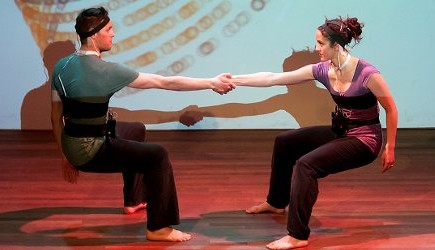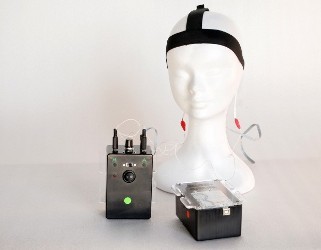Hacking Sensations
February 12, 2014
on
on

Luis Rodil-Fernández uses an Arduino to transport the sensation of balance from one person to another making the sensation of balance a networked feeling.
By Luis Rodil-Fernández
From the first stone tools to the latest smartphone, humans have relied upon technology for survival, the fate of humanity is inextricably linked to the technologies that we use. In this interdependence certain interesting side effects develop, technologies have an impact on our culture but also on the way we use our bodies. For example, the cost of musculoskeletal disorders related to the workplace is around 50 billion dollars a year. Gyms pop up like mushrooms near areas with high office density, treadmills often used to loosen up what the office chair stiffens. A google search of the term Kinect fails will result in multiple videos of people injuring themselves and others as well as bashing furniture as a result of using the Kinect sensor.
Computational somatics
Luis Rodil-Fernández, a Spanish artist working in Amsterdam, is interested in the relationship that our bodies develop with the computer, and in which ways one is subject to the other, he calls this area of interest Computational Somatics. Where biofeedback involves taking signals coming from the body into the digital domain, in Computational Somatics we do not make this distinction and look at computation in a more holistic light. Signals that originate in the digital domain can be provided as input to nerves as well.
 During the last two years he has been developing a device that affects the balance of the wearer. Based on an old principle discovered by Alessandro Volta, inventor of the battery. GVS stands for Galvanic Vestibular Stimulation. It consists of a small and short pulse of electricity sent through the skin into the vestibular system, the organ that coordinates the sensation of balance. This pulse causes the wearer to experience the sensation of a moving floor as if standing on a boat, making it very difficult to remain in balance. The device has the capability to make the sensation controlled, making the wearer lean left or right depending on the stimulus.
During the last two years he has been developing a device that affects the balance of the wearer. Based on an old principle discovered by Alessandro Volta, inventor of the battery. GVS stands for Galvanic Vestibular Stimulation. It consists of a small and short pulse of electricity sent through the skin into the vestibular system, the organ that coordinates the sensation of balance. This pulse causes the wearer to experience the sensation of a moving floor as if standing on a boat, making it very difficult to remain in balance. The device has the capability to make the sensation controlled, making the wearer lean left or right depending on the stimulus.
Networked feeling
Using simple off the shelf components and an Arduino board to run the stimulation software. Luis developed a system for the stage called BRAID in which the sensation of balance of two dancers becomes interconnected. BRAID is composed of two devices that can produce GVS stimulation on the wearer. The devices are networked wirelessly using an XBee module and they gather positional data from the wearer’s spine via an accelerometer positioned on top of their heads. When one of the wearers leans out of balance, her device detects this and sends a proportional stimulus to the wearer of the paired device, so it is the other person that feels it.
Together with dancers Almudena Ballesteros Parejo and Demian Haller, they produced a choreographed experiment in which the sensation of balance is used as a form of communication on stage. Making the sensation of balance a 'networked feeling'.
What would you do with such power over another person?
BRAID promo from Luis on Vimeo.
Top image: Almudena and Demian performing BRAID Derfunke.net
By Luis Rodil-Fernández
From the first stone tools to the latest smartphone, humans have relied upon technology for survival, the fate of humanity is inextricably linked to the technologies that we use. In this interdependence certain interesting side effects develop, technologies have an impact on our culture but also on the way we use our bodies. For example, the cost of musculoskeletal disorders related to the workplace is around 50 billion dollars a year. Gyms pop up like mushrooms near areas with high office density, treadmills often used to loosen up what the office chair stiffens. A google search of the term Kinect fails will result in multiple videos of people injuring themselves and others as well as bashing furniture as a result of using the Kinect sensor.
Computational somatics
Luis Rodil-Fernández, a Spanish artist working in Amsterdam, is interested in the relationship that our bodies develop with the computer, and in which ways one is subject to the other, he calls this area of interest Computational Somatics. Where biofeedback involves taking signals coming from the body into the digital domain, in Computational Somatics we do not make this distinction and look at computation in a more holistic light. Signals that originate in the digital domain can be provided as input to nerves as well.
 During the last two years he has been developing a device that affects the balance of the wearer. Based on an old principle discovered by Alessandro Volta, inventor of the battery. GVS stands for Galvanic Vestibular Stimulation. It consists of a small and short pulse of electricity sent through the skin into the vestibular system, the organ that coordinates the sensation of balance. This pulse causes the wearer to experience the sensation of a moving floor as if standing on a boat, making it very difficult to remain in balance. The device has the capability to make the sensation controlled, making the wearer lean left or right depending on the stimulus.
During the last two years he has been developing a device that affects the balance of the wearer. Based on an old principle discovered by Alessandro Volta, inventor of the battery. GVS stands for Galvanic Vestibular Stimulation. It consists of a small and short pulse of electricity sent through the skin into the vestibular system, the organ that coordinates the sensation of balance. This pulse causes the wearer to experience the sensation of a moving floor as if standing on a boat, making it very difficult to remain in balance. The device has the capability to make the sensation controlled, making the wearer lean left or right depending on the stimulus.Networked feeling
Using simple off the shelf components and an Arduino board to run the stimulation software. Luis developed a system for the stage called BRAID in which the sensation of balance of two dancers becomes interconnected. BRAID is composed of two devices that can produce GVS stimulation on the wearer. The devices are networked wirelessly using an XBee module and they gather positional data from the wearer’s spine via an accelerometer positioned on top of their heads. When one of the wearers leans out of balance, her device detects this and sends a proportional stimulus to the wearer of the paired device, so it is the other person that feels it.
Together with dancers Almudena Ballesteros Parejo and Demian Haller, they produced a choreographed experiment in which the sensation of balance is used as a form of communication on stage. Making the sensation of balance a 'networked feeling'.
What would you do with such power over another person?
BRAID promo from Luis on Vimeo.
Top image: Almudena and Demian performing BRAID Derfunke.net
Read full article
Hide full article


Discussion (0 comments)